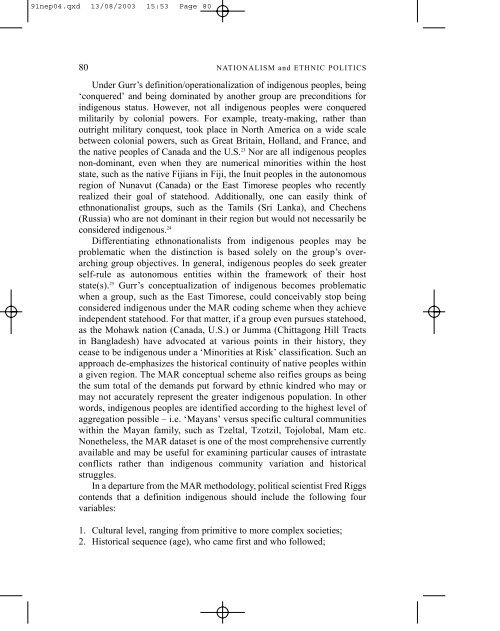Who is Indigenous? 'Peoplehood' and Ethnonationalist Approaches to Rearticulating Indigenous Identity
by Jeff J. Corntassel
by Jeff J. Corntassel
You also want an ePaper? Increase the reach of your titles
YUMPU automatically turns print PDFs into web optimized ePapers that Google loves.
91nep04.qxd 13/08/2003 15:53 Page 80<br />
80 NATIONALISM <strong>and</strong> ETHNIC POLITICS<br />
Under Gurr’s definition/operationalization of indigenous peoples, being<br />
‘conquered’ <strong>and</strong> being dominated by another group are preconditions for<br />
indigenous status. However, not all indigenous peoples were conquered<br />
militarily by colonial powers. or example, treaty-making, rather than<br />
outright military conquest, <strong>to</strong>ok place in North America on a wide scale<br />
between colonial powers, such as Great Britain, Holl<strong>and</strong>, <strong>and</strong> rance, <strong>and</strong><br />
the native peoples of Canada <strong>and</strong> the U.S. 23 Nor are all indigenous peoples<br />
non-dominant, even when they are numerical minorities within the host<br />
state, such as the native ijians in iji, the Inuit peoples in the au<strong>to</strong>nomous<br />
region of Nunavut (Canada) or the East Timorese peoples who recently<br />
realized their goal of statehood. Additionally, one can easily think of<br />
ethnonational<strong>is</strong>t groups, such as the Tamils (Sri Lanka), <strong>and</strong> Chechens<br />
(Russia) who are not dominant in their region but would not necessarily be<br />
considered indigenous. 24<br />
Differentiating ethnonational<strong>is</strong>ts from indigenous peoples may be<br />
problematic when the d<strong>is</strong>tinction <strong>is</strong> based solely on the group’s overarching<br />
group objectives. In general, indigenous peoples do seek greater<br />
self-rule as au<strong>to</strong>nomous entities within the framework of their host<br />
state(s). 25 Gurr’s conceptualization of indigenous becomes problematic<br />
when a group, such as the East Timorese, could conceivably s<strong>to</strong>p being<br />
considered indigenous under the MAR coding scheme when they achieve<br />
independent statehood. or that matter, if a group even pursues statehood,<br />
as the Mohawk nation (Canada, U.S.) or Jumma (Chittagong Hill Tracts<br />
in Bangladesh) have advocated at various points in their h<strong>is</strong><strong>to</strong>ry, they<br />
cease <strong>to</strong> be indigenous under a ‘Minorities at R<strong>is</strong>k’ classification. Such an<br />
approach de-emphasizes the h<strong>is</strong><strong>to</strong>rical continuity of native peoples within<br />
a given region. The MAR conceptual scheme also reifies groups as being<br />
the sum <strong>to</strong>tal of the dem<strong>and</strong>s put forward by ethnic kindred who may or<br />
may not accurately represent the greater indigenous population. In other<br />
words, indigenous peoples are identified according <strong>to</strong> the highest level of<br />
aggregation possible – i.e. ‘Mayans’ versus specific cultural communities<br />
within the Mayan family, such as Tzeltal, Tzotzil, Tojolobal, Mam etc.<br />
Nonetheless, the MAR dataset <strong>is</strong> one of the most comprehensive currently<br />
available <strong>and</strong> may be useful for examining particular causes of intrastate<br />
conflicts rather than indigenous community variation <strong>and</strong> h<strong>is</strong><strong>to</strong>rical<br />
struggles.<br />
In a departure from the MAR methodology, political scient<strong>is</strong>t red Riggs<br />
contends that a definition indigenous should include the following four<br />
variables:<br />
1. Cultural level, ranging from primitive <strong>to</strong> more complex societies;<br />
2. H<strong>is</strong><strong>to</strong>rical sequence (age), who came first <strong>and</strong> who followed;


















